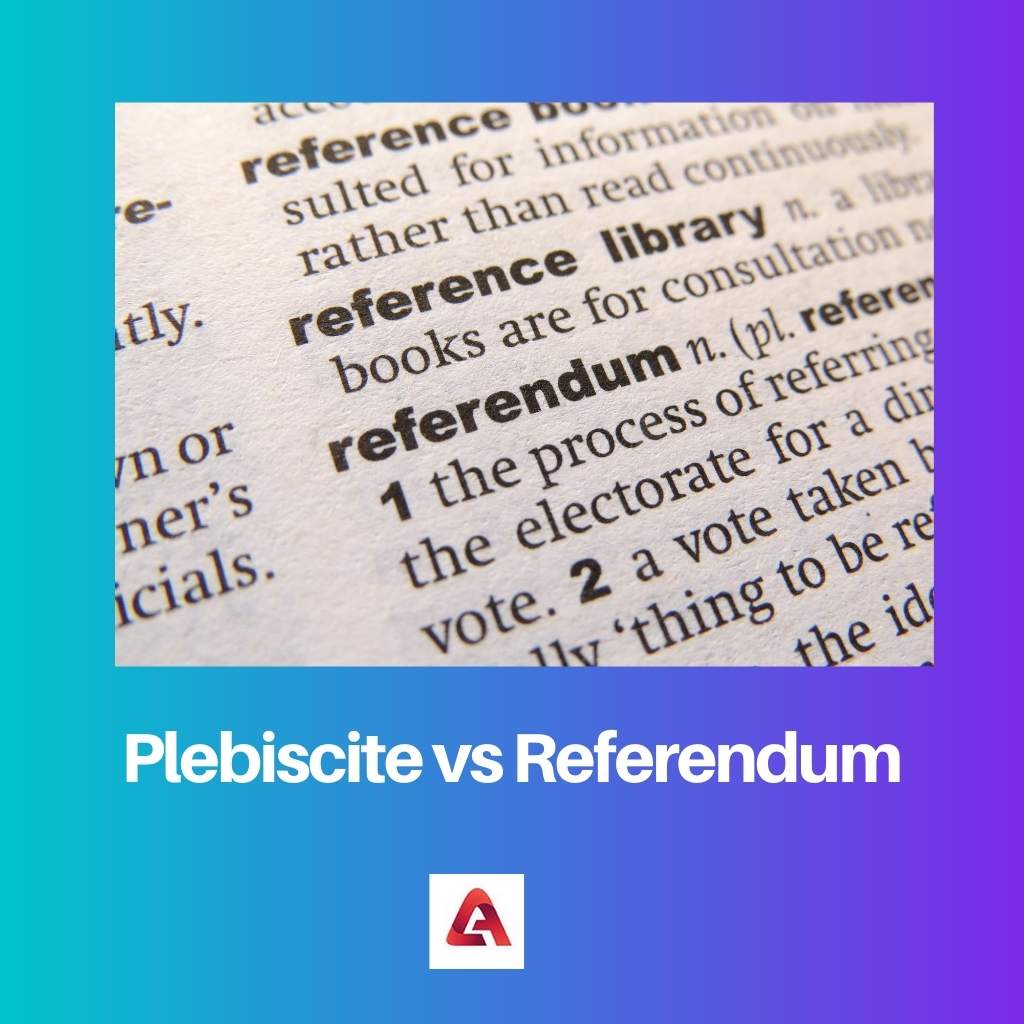There are many changes that take place in law. People do not understand these terms. A majority of laws are just passed by amendments and statutes or made by including them in the common law.
Even though this happens, some important issues do need public votes for decisions to be made. For this purpose, the terms plebiscite and Referendum were introduced.
Key Takeaways
- A plebiscite is a direct vote by the people to determine a political issue, such as a change in the constitution or sovereignty.
- A referendum is a general vote by the electorate on a specific proposal, such as a law or policy.
- Plebiscites resolve political crises, while referendums gauge public opinion on specific issues.
Plebiscite vs Referendum
A plebiscite is a type of vote which is given to identify an issue related to politics. This vote can also be given for policy change. This vote is initiated by the government. This vote can be given by anyone. A referendum is another type of vote which can be given on a particular proposal. This vote is initiated by the citizens.

The term plebiscite can also be called an advisory referendum. This arises due to the action on results which are taken on.
This term does not have any relationship with Constitution, but it does take all important decisions which are in the control and authority of a parliament to bring about a change.
The term referendum is called a Constitutional referendum. This helps to change the approval in a Constitution. A referred is the primary way to help bring about a change in an amendment in the Constitution.
A referendum is a primary way of doing this change, according to section 128. There is a need to have a double major for decisions taken regarding changes in amendments.
Comparison Table
| Parameters of Comparison | Plebiscite | Referendum |
|---|---|---|
| Environment | This occurs only under an undemocratic environment. | This occurs only under a democratic environment. |
| Aim | This aims in brings in a feeling of unity and empowerment in the government. | This aims in brings in a feeling of unity and empowerment in the people. |
| Main function | This a primary technique to legitimate a policy by the government. | This is a way of getting a stronger opinion in the masses. |
| Carried out by | This can be carried out only by some specific authority of people at the high post. | This can be carried out by a citizen or a group of people having the same motto. |
| Characteristic | This is a way of voting by itself. | This is a way of phrasing the vote. |
What is a Plebiscite?
The term plebiscite can also be called an advisory referendum. This arises due to the action on results which are taken on.
This term does not have any relationship with Constitution, but it does take all important decisions which are in the control and authority of a parliament to bring about a change.
For taking up a plebiscite, the government takes the consent of the general public before passing any changes in any act stated. There is a requirement of an act of parliament in a plebiscite to help accompany the proposal taken off in a parliament.
This act plays an essential role when it comes to deciding whether it is compulsory or not for people to vote in plebiscites.
There is no need to conduct a plebiscite in a specific order or way. There can be conduction of a plebiscite regarding the internal matters happening in that particular state.
For example, there was a plebiscite conducted by Australia to decide if the legalization of same-sex marriage should happen or no.

What is a Referendum?
The term referendum is called a Constitutional referendum. This helps to change the approval in a Constitution. A referred is the primary way to help bring about a change in an amendment in the Constitution.
A referendum is a primary way of doing this change, according to section 128. There is a need to have a double major for decisions taken regarding changes in amendments.
This means that there must be a majority of more than 50 percent of the people of that particular state. Just like how it is compulsory to vote for selecting the right candidate for our state or country through elections, Australians also have to vote in referendums.
There is a binding of a legal force on the government, which results in the Referendum.
There have been almost 45 referenda that have been taken since 1901, and only 8 of them have been accepted.
A very recent example of the Referendum is that, in Australia, a referendum took place to change Australia into a republic union, and it should tie up an Alice with the US. However, this Referendum was not passed since there were about 54% more votes against this Referendum.

Main Differences Between a Plebiscite and a Referendum
- A plebiscite occurs only in an undemocratic environment, and on the other hand, a referendum occurs only in a democratic environment.
- A plebiscite brings unity and empowerment in the government; on the other hand, a referendum brings a feeling of empowerment within the people.
- The technique of legitimate a policy by the government is called a plebiscite, and on the other hand, the way of getting a stronger opinion in the masses in a country is known as a referendum.
- A plebiscite can be carried out only by some specific authority of people at the high post, and on the other hand, a referendum can be carried out by a citizen or a group of people having the same motto.
- A plebiscite is a way of voting by itself, and on the other hand, a referendum is a way of phrasing the vote.
- https://strathprints.strath.ac.uk/id/eprint/59204
- https://books.google.com/books?hl=en&lr=&id=iOAthp-d7BUC&oi=fnd&pg=PA1&dq=plebiscite+vs+referendum&ots=Ka2oWWTFMq&sig=hUeulQFo9zktJbounAUQ9oTH7uE

The comparison of a plebiscite and a referendum is greatly elucidating, especially the detailed explanation of the functions of each.
The examples provided, such as the Australia same-sex marriage plebiscite, added depth to the discussion.
I found the explanation of the legal approval requirement for changes in the Constitution through a referendum very informative.
The article presents a detailed understanding of the differences between plebiscite and referendum, examining the environment, aim, main function, and other aspects of both.
The explanation of how a plebiscite aims to bring unity and empowerment in the government, while a referendum aims to empower people, was very informative.
The article offers a comprehensive comparison between plebiscite and referendum, shedding light on their significance and role in decision-making.
The discussion of the historical significance and modern applications of both plebiscite and referendum was very enriching.
The piece offers a comprehensive understanding of the differences between plebiscite and referendum and the contexts in which they are carried out.
The historical background provided for plebiscite and referendum was extremely insightful.
The article presents a distinct understanding of a plebiscite and a referendum, examining their implications and democratic nature thoroughly.
The comparison table was particularly helpful in understanding the key differences between plebiscite and referendum.
The historical perspective shared for both plebiscite and referendum really added value to the discussion.
The information provided about plebiscite and referendum was thorough, and the examples given further clarified the concepts.
The article provides a comprehensive overview of the roles and significance of plebiscites and referendums in making important decisions.
I appreciated the discussion on the legal force and outcomes of referendums.
The article provides an insightful comparison of a plebiscite and a referendum. The definitions given were succinct and clear.
The historical context provided for both plebiscite and referendum was particularly interesting.
I found the discussion on the aim and main function of plebiscite and referendum quite enlightening.
The piece offers a comprehensive view of the distinction between plebiscite and referendum, and the role each plays in deciding political matters.
I found the comparison table helpful in understanding the contrast between a plebiscite and a referendum in different contexts.
The information provided about plebiscite and referendum was comprehensive and gave a clear insight into both processes.
The article provides a well-structured comparison between plebiscite and referendum, outlining their characteristics and importance.
The explanations of the term plebiscite and its relationship to the Constitution were particularly enlightening.
I found the discussion about the legal force and historical acceptance of referendums quite engaging.